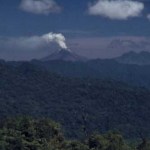italy
Its already Friday!
News!
Print of the Temple of Jupiter at Pompeii with a steaming Vesuvius in the background.
You can now wander down the streets of ancient Pompeii from the comfort of your own home or office. Google Streetview now cover the streets of the city wiped out by the 79 A.D. eruption of Vesuvius in Italy. Now, some of the articles on the Pompeii streetview give lipservice to the current threat of Vesuvius to the modern city of Naples, my favorite being:
The authorities continually monitor Vesuvius these days, and estimate they'll be able to give adequate warning if it's ever in…
Here is Part 2 of the Q&A with Dr. Boris Behncke. You can also check out Part 1.
Undated image of Stromboli in eruption.
(Shirakawa Akira) 1. Would a large scale eruption (VEI 5 or greater) of Mt. Etna like the ones occurred in 122 BC and 1500 BC (disputed) be possible again in the foreseeable future? Or is the volcano slowly "dying" although the last eruption ended in July 2009 has been one of the longest ever recorded?
2. Not really related to volcanism, but close: does INGV plan to distribute seismic data from seismic stations of its Rete Sismica Nazionale, including stations from…
First off, I want to thank Dr. Behncke for taking the time to answer your questions - and also, thank you to all who sent him some thought-provoking questions. In fact, the questions and answers take up about 12 pages of text, so the Q&A will be divided into two parts.
If you want to see one of the previous in the Q&A series, check out:
Dr. Jonathan Castro.
Question and Answer with Dr. Boris Behncke of the Italian National Institute of Geophysics and Volcanology in Catania.
Dr. Boris Behncke.
Questions for Dr. Boris Behncke
(Bernard Duyck) Qu'en est-il de l'évolution du mécanisme…
Back from Iowa, time for some volcano news. Look for the answers to your questions for Dr. Boris Behncke to get posted later this week.
(And thanks for all the comments and kind words in the Open Thread. I'll start thinking about how to implement a lot of these in the next few weeks).
Undated photo of Volcan Galeras in Colombia.
Galeras stopped traffic near Pasto, Colombia and prompted the evacuation of 1,000 people over the weekend when it erupted. The volcano apparently produced ash that covered towns near the volcano, including Pashto, and the highway connected that town with Pasto was…
It has been a slow week for volcano news (and a busy week for me), so I apologize for the abundance of MVPs this week. I've tried to find a good one in the many images submitted to me by Eruptions readers, and #15 is just one of those photos. If you have images you'd like to share with me for MVP or other uses, please email them to me at
. (However, I should note that you can't win by identifying your own volcano photo!)
MVP #13 was Lava Butte near Newberry volcano in Oregon. It is a lovely small scoria cone that you can walk/drive to the summit. From there, you get a spectacular view of the…
The volcanoes of Italy must have known that Dr. Boris Behncke would be in the Q&A spotlight here at Eruptions because three have shown signs of new activity over the last week. Here is a quick summary based on information from Dr. Behncke and Sonia Calvari of IGVN.
Etna erupting in 1989. Image by Dr. Boris Behncke.
Etna
On November 6, Etna in Italy appears to have entered a new phase of activity. The volcano had not produced any explosive events since July 4, 2009, but since 11/6, Etna has experienced a series of deep-seated explosive events - some of which suggest there is a lava lake…
Geologic and structural map showing the extent of the Campi Flegrei caldera on the north of the Bay of Naples, Italy. Image courtesy of INGV.
One of the writing assignments I always enjoyed in high school was the "compare and contrast". You could sit back and look for stylistic differences between writers and texts - potentially offering signs about the nature of the writers motivations.
I still find it fun - case in point, two article I read about the research drilling that is about to start at the Campei Flegrei in Italy. The Campei Flegrei is a large caldera system that most recently…
Just a reminder ...
Etna erupting in November 2002.
If you have any questions for Dr. Boris Behncke, who runs Italy's Volcanoes along with the volcanology page for the Italian National Institute of Geophysics and Volcanology in Catania, please send them in to me at
. I've got some good question so far!
The first Q&A with Dr. Jonathan Castro was such a success, I'm going to try to make this a regular feature. On that note, Eruptions reader Dr. Boris Behncke has volunteered to be the second geologist to take the plunge. Here is a little about Boris and his work:
I've studied geology first in Bochum, Germany, then finished my Master's in Kiel, Germany (in 1996), before hopping south to Catania, where I did my Ph.D. in 2001. I live in Sicily since early 1997, but first visited the Italian volcanoes in 1989, and happen to be at Etna when it produced a spectacular eruption just on schedule.…
Some brief tidbits for your Wednesday:
The view of Mt. Saint Helens from the Johnston Ridge Observatory.
There is a decent article about research being done at a dissected caldera system in the Italian Alps' Sesia Valley. The caldera in question is the Permian in age (248-298 million years old) so don't expect to find it in the GVP database, but the outcrops of this ancient caldera are especially well exposed, allowing for a cross section of volcano and plutonic rocks across 25 km of crustal depth (all of which is now at the surface thanks to hundreds of millions years of tectonics). It…
There are a couple article out today concerning volcanoes and the economy, one on the plus side, one on the minus side.
Volcano Buono in Italy near Naples.
First off, nothing like volcanism to get me stoked for buying stuff, eh? Actually, I have to admit, the Volcano Buono mall (yes, mall) in Italy near Naples (and yes, near Vesuvius) is one of the rather more attractive malls I've seen in a long time (above). It is designed to look like a volcano - I suppose it looks most like a monogenetic scoria cone, a little out of place for that part of Italy - but its design was based on trying use…
The latest in my Volcano Profiles Series, we turn to Europe and Vesuvius. You could fill many, many volumes with the works produced on Vesuvius since Roman times. This profile will barely scratch the surface when it comes to the vast geologic and human history surrounding the volcano, but it is a start. If you want to learn more about the archaeology surrounding Vesuvius, try visiting Blogging Pompeii.
VOLCANO PROFILE: MT. VESUVIUS
Mt. Vesuvius in Italy. Image courtesy of Dario Leone.
Location: Italy
Height: 1,281 m / 4,203 ft
Geophysical location: The tectonics in the Mediterranean are…
We've already talked about how many active volcanoes reside in Indonesia, but this week's USGS/SI update just drives that point home. Listed in the update are no less than 5 volcanoes were activity is being seen or is on the increase (Karangetang, Slamet, Dukono, Batu Tara and Makian). This doesn't mean mention the activity at Anak Krakatau, Rinjani or Semeru. Amazing.
Anyway, highlights - not counting Indonesia or the South American trio - from this week's report (as usual aptly put together by Sally Kuhn Sennert) include:
A ~8,000 foot / 2.4 km ash and steam plume from Bagana in Papua New…
I get a fairly steady stream of emails from Eruptions readers, some of which are very worth a post, but sometimes it takes me a while to get around to posting. This is my second attempt to catch up on these mailbag emails. Remember, feel free to email me questions or comments whether you want.
Reader Aldo Piombino sent me an email last month after my post on potential Antarctic volcanism asking about some more unknown volcanoes. He brings up Mt. Marsili in the Tyrrhenian Sea (including a post of his own, in Italian), a volcano of which I was not aware. It is a…
Sometimes I wonder if we know more about the fates of people who died in a volcanic eruption over 1800 years ago than we do about most people who died in any given eruption this year. Not that there is anything particularly wrong with that - we're fascinated by both volcanoes and Roman antiquity - but the level of detail done for the victims of Vesuvius in 79 A.D. is stunning.
Considering that this blog got started (to an extent) thanks to our cultural obsession with Pompeii, I thought it fitting to post a bit about a recent report on the last moments of a family in Pompeii. Nothing really…
The Discovery Channel brings us a story on how the exact (well, semi-exact if you read the article) date for the 79 A.D. eruption of Vesuvius has been nailed down by dating, well, fish sauce. The findings? The records of antiquity were right, it was probably around August 24, 79 A.D. and if you get to page 2, you'll find that the researchers - workers at the Pompeii's Applied Research Laboratory - say the fish sauce dates the eruption to somewhere in mid-August to mid-September. Why is this important? Recent archeological studies at Pompeii found a coin that dates to October of 79 A.D…
For those of us who track volcanoes and the hazards they present, the general consensus is that Mount Vesuvius in Italy is probably the most dangerous volcano in the world today. This is not because it is the biggest or most powerful, but because it is located on the outskirts of Naples, Italy, a city with over 2 million inhabitants (including the surrounding area). Evacuating such an area quickly and efficiently during a time of crisis might be, well, impossible. We know that Vesuvius can be destructive - just look at the fact that much of the Naples area is built on the…
Over the weekend, Mt. Etna (Italy) had some spectacular Strombolian fire-fountaining. Lucky for us, Marco Fulle and a group went up to the summit on Friday (the 13th) and got some great pictures of the current (ongoing) eruption which have been posted on Stromboli Online. Sounds like the eruption has been increasing in the past week, so it could be a busy summer in the Aeolian Island of Italy.
This Roe Deer was born in captivity at the research center of the Center of Natural Sciences just outside of Prato, Italy. With a single horn protruding from the center of its skull, Italian scientists believe that the animal either suffers from a unique genetic mutation or that it is a clear sign of the imminent second coming of Christ.
Special limited edition unicorn votives can be purchased at the Vatican this month only!
Single horned deer are rare, but not unheard of. However it is very unusual for the horn to be in the center of the head. Interestingly the unicorno's twin brother was…
If you're interested in the latest eruption at Mt. Etna (Italy), here are some great images posted at Stromboli Online. Nothing like some good spatter amongst friends.

